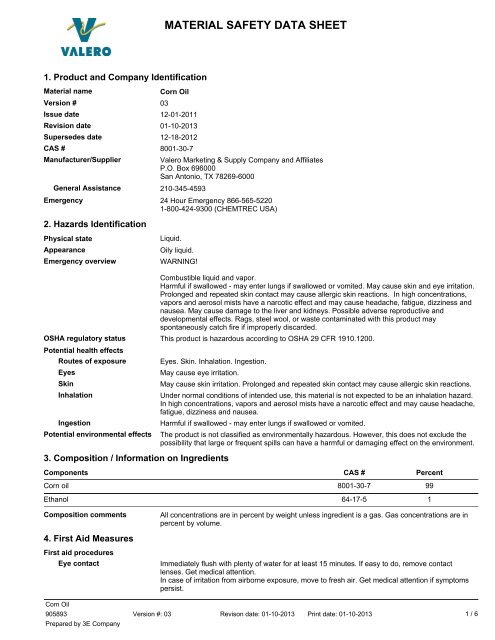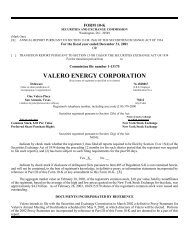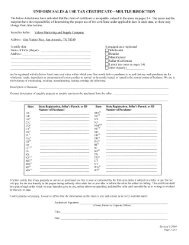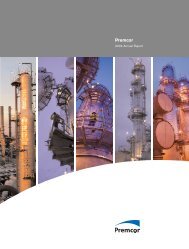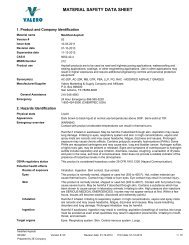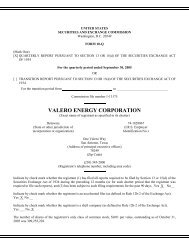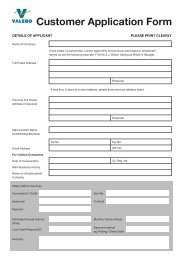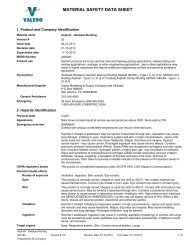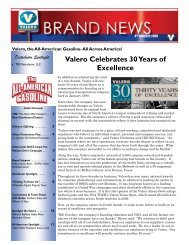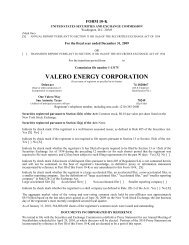Corn Oil - Valero
Corn Oil - Valero
Corn Oil - Valero
You also want an ePaper? Increase the reach of your titles
YUMPU automatically turns print PDFs into web optimized ePapers that Google loves.
MATERIAL SAFETY DATA SHEET1. Product and Company IdentificationMaterial nameVersion # 03<strong>Corn</strong> <strong>Oil</strong>Issue date 12-01-2011Revision date 01-10-2013Supersedes date 12-18-2012CAS # 8001-30-7Manufacturer/SupplierGeneral Assistance<strong>Valero</strong> Marketing & Supply Company and AffiliatesP.O. Box 696000San Antonio, TX 78269-6000210-345-4593Emergency 24 Hour Emergency 866-565-52201-800-424-9300 (CHEMTREC USA)2. Hazards IdentificationPhysical stateAppearanceEmergency overviewLiquid.<strong>Oil</strong>y liquid.WARNING!Combustible liquid and vapor.Harmful if swallowed - may enter lungs if swallowed or vomited. May cause skin and eye irritation.Prolonged and repeated skin contact may cause allergic skin reactions. In high concentrations,vapors and aerosol mists have a narcotic effect and may cause headache, fatigue, dizziness andnausea. May cause damage to the liver and kidneys. Possible adverse reproductive anddevelopmental effects. Rags, steel wool, or waste contaminated with this product mayspontaneously catch fire if improperly discarded.OSHA regulatory status This product is hazardous according to OSHA 29 CFR 1910.1200.Potential health effectsRoutes of exposureEyesSkinInhalationIngestionPotential environmental effectsEyes. Skin. Inhalation. Ingestion.May cause eye irritation.3. Composition / Information on IngredientsMay cause skin irritation. Prolonged and repeated skin contact may cause allergic skin reactions.Under normal conditions of intended use, this material is not expected to be an inhalation hazard.In high concentrations, vapors and aerosol mists have a narcotic effect and may cause headache,fatigue, dizziness and nausea.Harmful if swallowed - may enter lungs if swallowed or vomited.The product is not classified as environmentally hazardous. However, this does not exclude thepossibility that large or frequent spills can have a harmful or damaging effect on the environment.Components CAS # Percent<strong>Corn</strong> oilEthanolComposition comments8001-30-7 9964-17-5 1All concentrations are in percent by weight unless ingredient is a gas. Gas concentrations are inpercent by volume.4. First Aid MeasuresFirst aid proceduresEye contactImmediately flush with plenty of water for at least 15 minutes. If easy to do, remove contactlenses. Get medical attention.In case of irritation from airborne exposure, move to fresh air. Get medical attention if symptomspersist.<strong>Corn</strong> <strong>Oil</strong>905893Version #: 03Revison date: 01-10-2013 Print date: 01-10-2013CPH MSDS NA1 / 6Prepared by 3E Company
Skin contactInhalationIngestion5. Fire Fighting MeasuresFlammable propertiesExtinguishing mediaSuitable extinguishingmediaProtection of firefightersSpecific hazards arisingfrom the chemicalFire fightingequipment/instructionsSpecific methodsHazardous combustionproducts6. Accidental Release MeasuresImmediately flush with plenty of water for at least 15 minutes while removing contaminatedclothing and shoes. If skin irritation or an allergic skin reaction develops, get medical attention.Wash contaminated clothing before reuse. Destroy or thoroughly clean contaminated shoes.If symptomatic, move to fresh air. Get medical attention if symptoms persist.Call a physician or poison control center immediately. DO NOT induce vomiting. If victim is fullyconscious, give a cupful of water. Never give anything by mouth to an unconscious person. Ifvomiting occurs, keep head lower than the hips to help prevent aspiration.Combustible liquid and vapor. Test results from Sustained Combustion testing (ASTM D-4206)indicate that this material does not sustain combustion, however the material may cause a flashfire if exposed to an ignition source.Rags, steel wool, or waste contaminated with this product may spontaneously catch fire ifimproperly discarded.Water spray. Water fog. Foam. Dry chemical powder. Carbon dioxide (CO2). Halon.Containers may explode when heated.Self-contained breathing apparatus and full protective clothing must be worn in case of fire.Move container from fire area if it can be done without risk. Use water spray to keep fire-exposedcontainers cool.Carbon oxides. Nitrogen oxides. Hydrocarbons.Personal precautions Wear appropriate personal protective equipment (See Section 8).Methods for cleaning up7. Handling and StorageHandlingStorage8. Exposure Controls / Personal ProtectionOccupational exposure limitsUS. ACGIH Threshold Limit ValuesEliminate all ignition sources. Absorb spill with vermiculite or other inert material, then place in asealed container for chemical waste. Used rags or other cleaning materials should be soaked withwater and placed in a sealed container.Large Spills: Flush area with water. Prevent runoff from entering drains, sewers, or streams. Dikefor later disposal.Immediately after use, place rags, steel wool, or waste in a sealed water-filled metal container.Avoid breathing mist/vapors/spray. Avoid contact with eyes, skin, and clothing. Do not taste orswallow. Use only with adequate ventilation. Wash thoroughly after handling. Observe goodindustrial hygiene practices.Keep container closed. Protect from light. Store in a cool place.ComponentsTypeEthanol (CAS 64-17-5)STELUS. OSHA Table Z-1 Limits for Air Contaminants (29 CFR 1910.1000)Value1000 ppmMaterial<strong>Corn</strong> <strong>Oil</strong> (CAS 8001-30-7)ComponentsEthanol (CAS 64-17-5)TypeValueFormPEL 5 mg/m3 Respirable fraction.15 mg/m3 Total dust.TypeValuePEL1900 mg/m31000 ppm<strong>Corn</strong> <strong>Oil</strong>905893Prepared by 3E CompanyVersion #: 03Revison date: 01-10-2013 Print date: 01-10-2013CPH MSDS NA2 / 6
Canada. Alberta OELs (Occupational Health & Safety Code, Schedule 1, Table 2)ComponentsEthanol (CAS 64-17-5)TypeTWAValue1880 mg/m31000 ppmCanada. British Columbia OELs. (Occupational Exposure Limits for Chemical Substances, Occupational Health andSafety Regulation 296/97, as amended)Material<strong>Corn</strong> <strong>Oil</strong> (CAS 8001-30-7)ComponentsEthanol (CAS 64-17-5)TypeValueFormTWA 3 mg/m3 Respirable mist.10 mg/m3 Mist.TypeValueSTELCanada. Ontario OELs. (Control of Exposure to Biological or Chemical Agents)Material<strong>Corn</strong> <strong>Oil</strong> (CAS 8001-30-7)ComponentsEthanol (CAS 64-17-5)Type1000 ppmValueFormTWA 10 mg/m3 Mist.TypeValueSTEL1000 ppmCanada. Quebec OELs. (Ministry of Labor - Regulation Respecting the Quality of the Work Environment)Material<strong>Corn</strong> <strong>Oil</strong> (CAS 8001-30-7)ComponentsEthanol (CAS 64-17-5)Mexico. Occupational Exposure Limit ValuesMaterial<strong>Corn</strong> <strong>Oil</strong> (CAS 8001-30-7)ComponentsEthanol (CAS 64-17-5)Engineering controlsPersonal protective equipmentEye / face protectionSkin protectionRespiratory protectionGeneral hygieneconsiderations9. Physical & Chemical PropertiesAppearancePhysical stateFormColorOdorOdor thresholdpHVapor pressureTypeValueFormTWA 10 mg/m3 Mist.TypeValueTWAType1880 mg/m31000 ppmValueFormTWA 10 mg/m3 Mist.TypeValueTWAEnsure adequate ventilation, especially in confined areas.Wear safety glasses with side shields (or goggles).1900 mg/m31000 ppmWear chemical-resistant gloves, footwear and protective clothing appropriate for risk of exposure.Contact glove manufacturer for specific information.If engineering controls do not maintain airborne concentrations below recommended exposurelimits (where applicable) or to an acceptable level (in countries where exposure limits have notbeen established), an approved respirator must be worn. In the United States of America, ifrespirators are used, a program should be instituted to assure compliance with OSHA 29 CFR1910.134. Respirator type: Use NIOSH approved respirator with organic vapor/acid gasprotection.Always observe good personal hygiene measures, such as washing after handling the materialand before eating, drinking, and/or smoking. Routinely wash work clothing and protectiveequipment to remove contaminants.<strong>Oil</strong>y liquid.Liquid.<strong>Oil</strong>.Light yellow.Slight characteristic odor.Not available.Not available.Not available.<strong>Corn</strong> <strong>Oil</strong>905893Prepared by 3E CompanyVersion #: 03Revison date: 01-10-2013 Print date: 01-10-2013CPH MSDS NA3 / 6
Vapor densityBoiling pointMelting point/Freezing pointSolubility (water)Specific gravity 0.918Not available.Not available.6.8 °F (-14 °C) / 32 °F (0 °C) ApproximateInsoluble in cold water.Flash point 158 °F (70 °C) Closed Cup (This material does not support combustion - see Section 5)465.8 °F (241 °C) Cleveland Open CupFlammability limits in air,upper, % by volumeFlammability limits in air,lower, % by volumeAuto-ignition temperature19 % (Ethanol)3.3 % (Ethanol)Not available.10. Chemical Stability & Reactivity InformationChemical stabilityConditions to avoidIncompatible materialsHazardous decompositionproductsPossibility of hazardousreactionsMaterial is stable under normal conditions.Heat, sparks, flames, elevated temperatures.Strong oxidizing agents. Acids. Alkalis.No hazardous decomposition products are known.Hazardous polymerization does not occur.11. Toxicological InformationSensitizationAcute effectsChronic effectsCarcinogenicityACGIH CarcinogensEthanol (CAS 64-17-5)Reproductive effectsProlonged and repeated skin contact may cause allergic skin reactions.Harmful if swallowed - may enter lungs if swallowed or vomited. May cause skin and eye irritation.In high concentrations, vapors and aerosol mists have a narcotic effect and may cause headache,fatigue, dizziness and nausea.The substance is toxic to blood, the reproductive system, liver, upper respiratory tract, skin,central nervous system (CNS). Repeated or prolonged exposure to the substance can producetarget organs damage. Contains material that may adversely affect the developing fetus.IARC has classified ethanol in alcoholic beverages as Group 1 (carcinogenic to humans). Ethanolalone has not been evaluated for carcinogenicity by IARC.A3 Confirmed animal carcinogen with unknown relevance tohumans.Ethanol has demonstrated human effects of reproductive toxicity.12. Ecological InformationEcotoxicityPersistence and degradabilityBioaccumulation /AccumulationMobility in environmentalmediaNot expected to be harmful to aquatic organisms.No data available.No data available.No data available.13. Disposal ConsiderationsDisposal instructionsWaste from residues / unusedproductsContaminated packagingDispose of contents/container in accordance with local/regional/national/internat ional regulations.When this product as supplied is to be discarded as waste, it does not meet the definition of aRCRA waste under 40 CFR 261.Dispose of in accordance with local regulations.Since emptied containers may retain product residue, follow label warnings even after container isemptied.14. Transport InformationDOTNot regulated as a hazardous material by DOT.<strong>Corn</strong> <strong>Oil</strong>905893Prepared by 3E CompanyVersion #: 03Revison date: 01-10-2013 Print date: 01-10-2013CPH MSDS NA4 / 6
IATANot regulated as dangerous goods.IMDGNot regulated as dangerous goods.TDGNot regulated as dangerous goods.General15. Regulatory InformationTest results from Sustained Combustion testing (ASTM D-4206) indicate that this material doesnot sustain combustion.US federal regulations This product is hazardous according to OSHA 29 CFR 1910.1200.All components are on the U.S. EPA TSCA Inventory List.TSCA Section 12(b) Export Notification (40 CFR 707, Subpt. D)Not regulated.Clean Air Act (CAA) Section 112 Hazardous Air Pollutants (HAPs) ListNot regulated.CERCLA (Superfund) reportable quantity (lbs) (40 CFR 302.4)NoneSuperfund Amendments and Reauthorization Act of 1986 (SARA)Hazard categoriesSection 302 extremelyhazardous substance (40CFR 355, Appendix A)Section 311/312 (40 CFR370)Drug EnforcementAdministration (DEA) (21 CFR1308.11-15)WHMIS statusWHMIS classificationWHMIS labelingImmediate Hazard - YesDelayed Hazard - YesFire Hazard - YesPressure Hazard - NoReactivity Hazard - NoNoYesNot controlledControlledB3 - Combustible LiquidsD2A - Other Toxic Effects-VERY TOXICD2B - Other Toxic Effects-TOXICInventory statusCountry(s) or region Inventory name On inventory (yes/no)*AustraliaAustralian Inventory of Chemical Substances (AICS)YesCanadaCanadaChinaEuropeEuropeJapanKoreaNew ZealandDomestic Substances List (DSL)Non-Domestic Substances List (NDSL)Inventory of Existing Chemical Substances in China (IECSC)European Inventory of Existing Commercial ChemicalSubstances (EINECS)European List of Notified Chemical Substances (ELINCS)Inventory of Existing and New Chemical Substances (ENCS)Existing Chemicals List (ECL)New Zealand InventoryYesNoYesYesNoNoYesYes<strong>Corn</strong> <strong>Oil</strong>905893Prepared by 3E CompanyVersion #: 03Revison date: 01-10-2013 Print date: 01-10-2013CPH MSDS NA5 / 6
Country(s) or region Inventory name On inventory (yes/no)*PhilippinesPhilippine Inventory of Chemicals and Chemical SubstancesYes(PICCS)United States & Puerto RicoToxic Substances Control Act (TSCA) Inventory*A "Yes" indicates this product complies with the inventory requirements administered by the governing country(s)State regulationsThis product does not contain a chemical known to the State of California to cause cancer, birthdefects or other reproductive harm.US - California Hazardous Substances (Director's): Listed substanceEthanol (CAS 64-17-5)Listed.US - California Proposition 65 - Carcinogens & Reproductive Toxicity (CRT): Listed substanceNot listed.US - New Jersey RTK - Substances: Listed substanceEthanol (CAS 64-17-5)US. Massachusetts RTK - Substance ListListed.<strong>Corn</strong> oil (CAS 8001-30-7)Listed.Ethanol (CAS 64-17-5)Listed.US. New Jersey Worker and Community Right-to-Know ActNot regulated.US. Pennsylvania RTK - Hazardous Substances<strong>Corn</strong> oil (CAS 8001-30-7)Ethanol (CAS 64-17-5)16. Other InformationFurther informationHMIS® ratings Health: 2*Flammability: 2Physical hazard: 0NFPA ratings Health: 2Flammability: 2Instability: 0DisclaimerListed.Listed.HMIS® is a registered trade and service mark of the NPCA.This Material Safety Data Sheet (MSDS) was prepared in accordance with 29 CFR 1910.1200 by<strong>Valero</strong> Marketing & Supply Co., ("VALERO"). VALERO does not assume any liability arising out ofproduct use by others. The information, recommendations, and suggestions presented in thisMSDS are based upon test results and data believed to be reliable. The end user of the producthas the responsibility for evaluating the adequacy of the data under the conditions of use,determining the safety, toxicity and suitability of the product under these conditions, and obtainingadditional or clarifying information where uncertainty exists. No guarantee expressed or implied ismade as to the effects of such use , the results to be obtained, or the safety and toxicity of theproduct in any specific application. Furthermore, the information herein is not represented asabsolutely complete, since it is not practicable to provide all the scientific and study information inthe format of this document, plus additional information may be necessary under exceptionalconditions of use, or because of applicable laws or government regulations.Yes<strong>Corn</strong> <strong>Oil</strong>905893Prepared by 3E CompanyVersion #: 03Revison date: 01-10-2013 Print date: 01-10-2013CPH MSDS NA6 / 6


